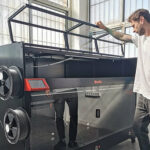Deutsche Bahn, a Berlin-based railway company, has integrated 3D printing into its maintenance network to produce hard-to-find parts for older trains as well as lighter parts for newer trains. They started Mobility goes Additive to invite relevant companies, institutions, and research firms to form partnerships that embrace additive manufacturing to create industrial solutions.
Partnering for the Future
Stefanie Brickwede, head of additive manufacturing at Deutsche Bahn and managing director of Mobility goes Additive commented on the network: “We just celebrated the second birthday of our (MgA) network which has grown from nine members to 19. From those figures you can get a sense of how important our subject is and the number of companies who want to focus on industrial use cases for printing spare parts.” There are some serious players in that member list, such as EOS, Siemens, BASF, BigRep, Materialise, Stratasys, 3D Systems, HP, Ultimaker, and Autodesk.
Trains are a fantastic use case of 3D printing; they are extremely mechanical with lots of moving parts, they operate for decades at a time and require replacement parts throughout their use, and they cover entire continents with their routes. Sometimes trains need replacement parts when they’re nowhere near those parts, which then have to be shipped to the train or the train has to be towed to the parts, causing downtime of a train that could be loaded with precious cargo that’s needed in various locations. An additive manufacturing network could greatly reduce those downtimes by rapidly fabricating replacement parts closer to the trains that break down.
Extended Service Times with 3D Printing
Other times, trains are so old that replacement parts become hard to find. “When we buy trains we get the service level agreement for delivery of spare parts for around 15 years,” said Brickwede. “After that time, we look for the parts on the world market and we cannot get them.” But they can 3D print them, and they do. From coat hooks to headrest frames, more and more of their trains are comprised of 3D printed components.
“We have a very broad range of use cases and very nice examples of parts increasing comfort too,” said Brickwede. “We also use a lot of different materials. Two-thirds of the parts we produce are made from plastic, the rest from metal. We have different polymers, and metals including aluminum steel and more recently titanium.” 3D printing is now used in nearly every type of transportation, including cars, motorcycles, bikes, ships, trains, planes, and even rockets.










